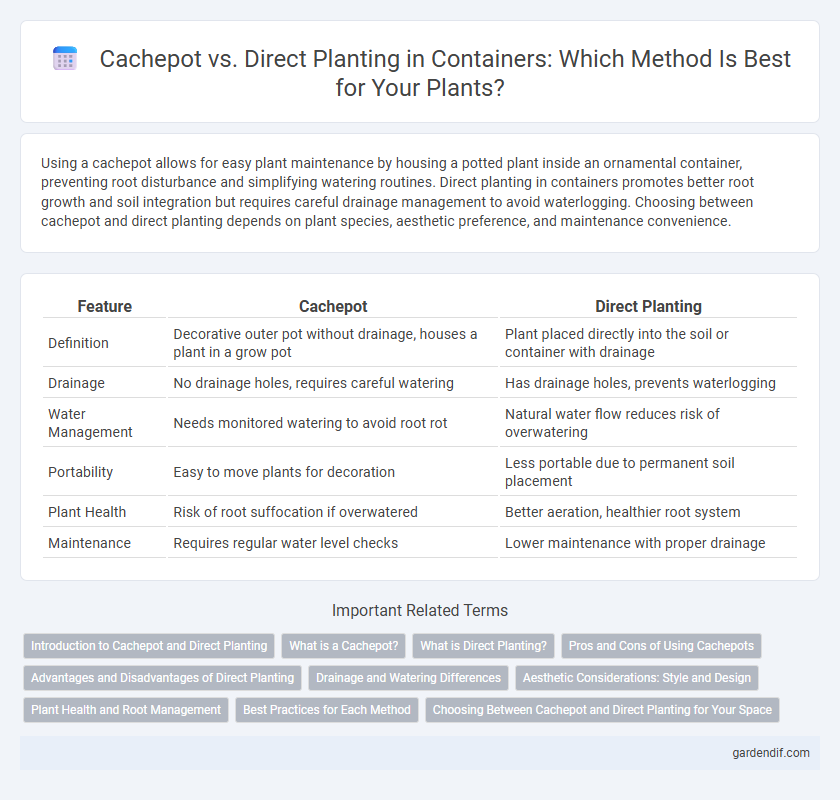
Cachepot vs direct planting Illustration
Using a cachepot allows for easy plant maintenance by housing a potted plant inside an ornamental container, preventing root disturbance and simplifying watering routines. Direct planting in containers promotes better root growth and soil integration but requires careful drainage management to avoid waterlogging. Choosing between cachepot and direct planting depends on plant species, aesthetic preference, and maintenance convenience.
Table of Comparison
| Feature | Cachepot | Direct Planting |
|---|---|---|
| Definition | Decorative outer pot without drainage, houses a plant in a grow pot | Plant placed directly into the soil or container with drainage |
| Drainage | No drainage holes, requires careful watering | Has drainage holes, prevents waterlogging |
| Water Management | Needs monitored watering to avoid root rot | Natural water flow reduces risk of overwatering |
| Portability | Easy to move plants for decoration | Less portable due to permanent soil placement |
| Plant Health | Risk of root suffocation if overwatered | Better aeration, healthier root system |
| Maintenance | Requires regular water level checks | Lower maintenance with proper drainage |
Introduction to Cachepot and Direct Planting
Cachepots serve as decorative containers designed to hold potted plants, offering aesthetic appeal while protecting surfaces from water damage and soil spillage. Direct planting involves placing plants directly into containers with drainage, promoting root health and easier growth management. Choosing between a cachepot and direct planting depends on balancing visual preferences with plant care requirements and container functionality.
What is a Cachepot?
A cachepot is an ornamental container designed to hold a plant pot, providing aesthetic appeal without direct soil contact. Unlike direct planting, where roots grow directly into the container's soil, a cachepot allows for better drainage and airflow by housing the plant's original pot inside. This method prevents root rot and makes it easier to switch plants, enhancing both plant health and decorative flexibility.
What is Direct Planting?
Direct planting involves placing plants or seeds directly into a container's soil without using an inner pot or liner, allowing roots to grow freely and establish better contact with the substrate. This method promotes healthier root development and reduces transplant shock by eliminating the need to transfer plants from one container to another. Gardeners often prefer direct planting for improved aeration, moisture retention, and more efficient nutrient absorption in container gardening.
Pros and Cons of Using Cachepots
Cachepots protect delicate plants from root damage and improve aesthetic appeal by hiding unattractive nursery pots, offering a reusable and versatile container solution. They provide better drainage control, reducing the risk of overwatering, but may require more frequent watering since excess water can drain into the outer pot and be trapped. However, cachepots can limit airflow to roots if not properly managed, potentially causing root rot or mold issues when moisture buildup occurs.
Advantages and Disadvantages of Direct Planting
Direct planting in containers allows plants to establish roots naturally without transplant shock, promoting healthier growth and reducing initial costs by eliminating the need for a cachepot. However, direct planting can limit aesthetic flexibility, as the container itself must be decorative and functional for both drainage and root space. The absence of a cachepot means less control over moisture retention and potential challenges in maintaining optimal soil conditions.
Drainage and Watering Differences
Cachepots offer limited drainage since they typically lack built-in holes, requiring careful watering to avoid root rot, whereas direct planting containers often feature drainage holes that facilitate excess water release. Watering in cachepots demands using a liner pot with drainage or watering cautiously to prevent water accumulation at the bottom. Direct planting promotes healthier root systems by ensuring consistent moisture levels and air circulation through proper drainage.
Aesthetic Considerations: Style and Design
Cachepots offer a stylish way to conceal less attractive plastic pots, enhancing the overall aesthetic of indoor and outdoor container arrangements. Direct planting in decorative containers allows for a seamless, cohesive look but may require more careful soil and drainage management to protect both plant and vessel. The choice between cachepots and direct planting hinges on balancing design preferences with practical considerations like ease of maintenance and plant health.
Plant Health and Root Management
Cachepots provide improved root aeration and controlled moisture retention, reducing the risk of root rot compared to direct planting in containers. They allow easier monitoring of root development and simplify repotting, promoting healthier growth by preventing soil compaction and nutrient depletion. Direct planting offers less flexibility in drainage management, which can lead to poor root health if container soil becomes waterlogged or lacks sufficient airflow.
Best Practices for Each Method
Cachepots allow for easy seasonal changes and protect delicate root systems by using a non-porous inner pot to hold soil and water, while the decorative outer container enhances aesthetic appeal. Direct planting requires well-draining soil and containers with adequate drainage holes to prevent root rot and ensure optimal aeration. Selecting the right container size matching root growth and regularly monitoring moisture levels are essential best practices for both methods to promote healthy plant development.
Choosing Between Cachepot and Direct Planting for Your Space
Selecting between a cachepot and direct planting depends on space, aesthetics, and plant care needs. Cachepots offer flexibility, allowing easy plant swapping and better moisture control through inner pots, ideal for indoor environments with limited space. Direct planting into containers maximizes soil volume for root growth and suits outdoor areas where drainage and natural conditions benefit the plant's health.
Cachepot vs direct planting Infographic

 gardendif.com
gardendif.com